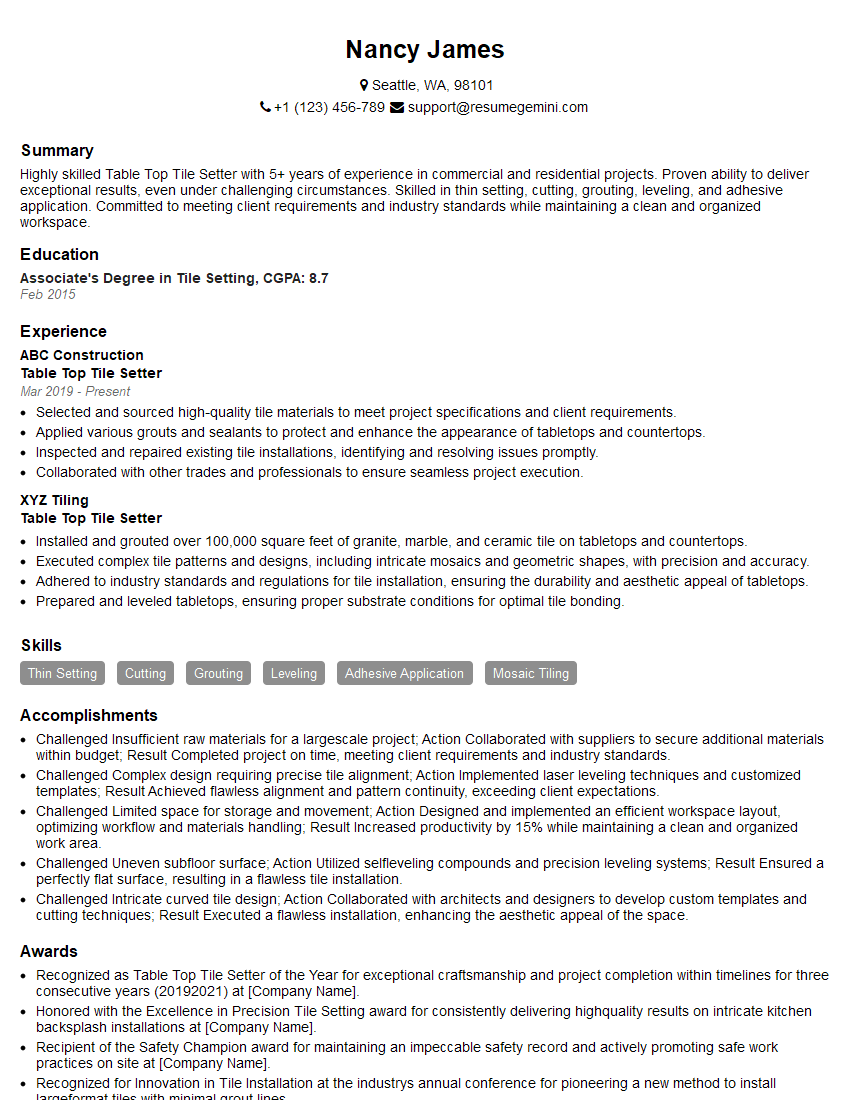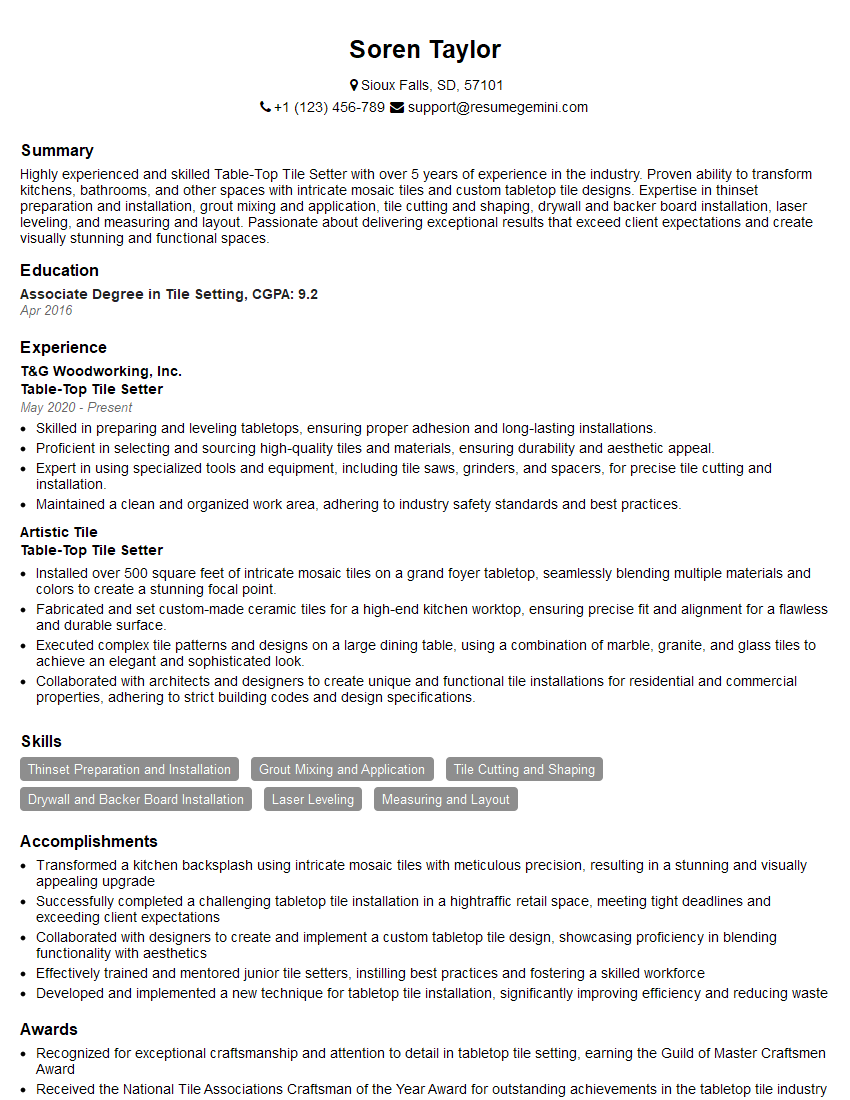Are you gearing up for a career in Table Top Tile Setter? Feeling nervous about the interview questions that might come your way? Don’t worry, you’re in the right place. In this blog post, we’ll dive deep into the most common interview questions for Table Top Tile Setter and provide you with expert-backed answers. We’ll also explore the key responsibilities of this role so you can tailor your responses to showcase your perfect fit.
Acing the interview is crucial, but landing one requires a compelling resume that gets you noticed. Crafting a professional document that highlights your skills and experience is the first step toward interview success. ResumeGemini can help you build a standout resume that gets you called in for that dream job.
Essential Interview Questions For Table Top Tile Setter
1. What are the most important considerations when choosing tiles for a tabletop?
When choosing tiles for a tabletop, there are several important considerations to keep in mind:
- Durability: The tiles should be able to withstand regular use and wear and tear, including spills, scratches, and heat.
- Resistance to moisture: The tiles should be resistant to moisture, as tabletops are often exposed to spills and condensation.
- Aesthetics: The tiles should complement the style of the table and the surrounding décor.
- Size and shape: The size and shape of the tiles should be appropriate for the size and shape of the tabletop.
- Cost: The cost of the tiles should be within your budget.
2. What are the different types of tile setting methods?
Grout Method
- Spreading thin-set mortar on the subfloor.
- Placing tiles into the mortar.
- Spreading grout over the tiles.
Mastic Method
- Applying mastic to the back of the tiles.
- Pressing the tiles into the subfloor.
Dry Lay Method
- Laying tiles on the subfloor without using any adhesive.
- Using spacers to ensure even spacing between the tiles.
3. What are the most common mistakes made when setting tiles?
- Not using the right tools: Using the right tools for the job can make a big difference in the quality of the finished product.
- Not preparing the surface properly: The surface should be clean, level, and dry before you start setting tiles.
- Not using enough thin-set mortar: Not using enough thin-set mortar can cause the tiles to become loose and fall off.
- Not spacing the tiles evenly: Unevenly spaced tiles can make the finished product look unprofessional.
- Grouting too soon: The thin-set mortar needs time to dry before you can grout the tiles.
4. What are the special considerations when setting tiles on a tabletop?
- The tabletop should be level: A level tabletop will ensure that the tiles are set evenly.
- The tabletop should be able to support the weight of the tiles: The weight of the tiles can vary depending on the type of tile and the size of the tabletop.
- The tabletop should be protected from moisture: Moisture can damage the tiles and the tabletop.
- The tiles should be sealed: Sealing the tiles will protect them from stains and damage.
5. What are your favorite types of tiles to use for tabletops?
- Ceramic tiles: Ceramic tiles are a popular choice for tabletops because they are durable, resistant to moisture, and easy to clean.
- Porcelain tiles: Porcelain tiles are a more durable and expensive option than ceramic tiles, but they are also more resistant to moisture and stains.
- Natural stone tiles: Natural stone tiles, such as marble and granite, are a beautiful and unique option for tabletops, but they are also more expensive and require more maintenance.
- Glass tiles: Glass tiles are a great option for adding a splash of color and style to a tabletop, but they are more fragile than other types of tiles.
6. What are your techniques for creating a seamless look when setting tiles on a tabletop?
- Use large tiles: Large tiles will create a more seamless look than smaller tiles.
- Use a thin grout line: A thin grout line will make the tiles look more like a single surface.
- Use a matching grout color: A matching grout color will help to create a seamless look.
- Seal the grout: Sealing the grout will help to protect it from stains and damage.
7. What are your tips for cutting tiles?
- Use a sharp tile cutter: A sharp tile cutter will make clean, straight cuts.
- Use a miter box: A miter box will help you to cut angles accurately.
- Use a wet saw: A wet saw is the best option for cutting tiles that are thick or made of hard materials.
- Practice on scrap tiles: Before you start cutting tiles for your tabletop, practice on scrap tiles to get the hang of it.
8. How do you deal with uneven surfaces when setting tiles?
- Use a self-leveling compound: A self-leveling compound can be used to level out uneven surfaces.
- Use shims: Shims can be used to level out individual tiles.
- Cut tiles to fit: Tiles can be cut to fit uneven surfaces.
9. What are your tips for grouting tiles?
- Use a grout float: A grout float is a tool that is used to apply grout.
- Mix the grout according to the manufacturer’s instructions: Grout should be mixed to the proper consistency.
- Apply the grout evenly: Grout should be applied evenly to the tiles.
- Wipe off the excess grout: Excess grout should be wiped off the tiles immediately.
- Seal the grout: Grout should be sealed to protect it from stains and damage.
10. What are your tips for maintaining a tiled tabletop?
- Sweep or vacuum the tabletop regularly: This will help to remove dirt and debris.
- Wipe down the tabletop with a damp cloth: This will help to remove spills and stains.
- Use a mild cleaner to clean the tabletop: Harsh cleaners can damage the tiles or the grout.
- Seal the grout regularly: This will help to protect it from stains and damage.
Interviewers often ask about specific skills and experiences. With ResumeGemini‘s customizable templates, you can tailor your resume to showcase the skills most relevant to the position, making a powerful first impression. Also check out Resume Template specially tailored for Table Top Tile Setter.
Career Expert Tips:
- Ace those interviews! Prepare effectively by reviewing the Top 50 Most Common Interview Questions on ResumeGemini.
- Navigate your job search with confidence! Explore a wide range of Career Tips on ResumeGemini. Learn about common challenges and recommendations to overcome them.
- Craft the perfect resume! Master the Art of Resume Writing with ResumeGemini’s guide. Showcase your unique qualifications and achievements effectively.
- Great Savings With New Year Deals and Discounts! In 2025, boost your job search and build your dream resume with ResumeGemini’s ATS optimized templates.
Researching the company and tailoring your answers is essential. Once you have a clear understanding of the Table Top Tile Setter‘s requirements, you can use ResumeGemini to adjust your resume to perfectly match the job description.
Key Job Responsibilities
A Table Top Tile Setter, also known as a Tile Setter Assistant, is a skilled professional who works under the supervision of an experienced tile setter to assist in the installation, repair, and maintenance of tile surfaces on table tops, countertops, backsplashes, and other flat surfaces. Their duties involve assisting in the preparation of the work area, ensuring proper substrate installation, mixing and applying mortars and adhesives, cutting and positioning tiles, and maintaining cleanliness throughout the project. To excel in this role, a Table Top Tile Setter requires a strong attention to detail, a keen eye for aesthetics, and the ability to follow instructions precisely.
1. Surface Preparation and Inspection
Prior to the installation of tiles, the Table Top Tile Setter assists in preparing the work area by ensuring the surface is level, smooth, and free of any debris or imperfections. They may assist in inspecting the substrate and ensure it adheres to the manufacturer’s specifications for compatibility with the tiles being installed.
2. Mortar and Adhesive Preparation
The Table Top Tile Setter assists in preparing the mortar or adhesive used to bond the tiles to the surface. They may follow specific mixing ratios and instructions to achieve the desired consistency and workability.
3. Tile Cutting and Positioning
Using specialized tools, the Table Top Tile Setter assists in cutting the tiles to the required shapes and sizes. They work closely with the lead tile setter to ensure proper alignment and spacing of the tiles, maintaining a consistent pattern and aesthetic appeal.
4. Tile Installation and Grouting
The Table Top Tile Setter helps in applying the mortar or adhesive to the tiles and carefully placing them on the prepared surface. They may assist in pressing and adjusting the tiles to ensure proper adhesion and alignment. Once the tiles are installed, they may assist in applying grout to fill the spaces between the tiles, enhancing the overall finish and durability of the surface.
5. Cleanup and Maintenance
Throughout the project, the Table Top Tile Setter maintains a clean work environment. They assist in removing excess mortar or adhesive, clean the installed tiles, and ensure the work area is left in a presentable condition. They may also assist in providing basic maintenance tips to the client for the upkeep of the tiled surface.
Interview Tips
Preparing thoroughly for an interview can significantly increase your chances of making a positive impression and securing the job. Here are some tips to help you ace the interview for a Table Top Tile Setter position:
1. Research the Company and Position
Take the time to learn about the company you’re applying to and the specific role of a Table Top Tile Setter within their organization. Familiarize yourself with their values, mission, and the projects they have undertaken. This knowledge will enable you to tailor your answers to the interviewer’s questions and demonstrate your genuine interest in the position.
2. Highlight Relevant Skills and Experience
During the interview, emphasize your skills and experience that are directly relevant to the responsibilities of a Table Top Tile Setter. Share specific examples from your previous work that showcase your proficiency in surface preparation, mortar and adhesive handling, tile cutting and installation, and cleanup procedures. Quantify your accomplishments whenever possible to provide tangible evidence of your contributions.
3. Showcase Attention to Detail and Precision
Table Top Tile Setting requires a high level of attention to detail and precision. In the interview, highlight your ability to focus on the minutiae and ensure accuracy in your work. Provide examples of situations where you meticulously followed instructions, maintained consistent quality standards, and achieved exceptional results in tile installation projects.
4. Communicate Effectively
Effective communication is crucial for working as a Table Top Tile Setter. Demonstrate your ability to clearly understand instructions, ask clarifying questions, and convey information effectively to both supervisors and clients. Share examples of how you have successfully collaborated on projects and maintained positive working relationships.
5. Prepare Questions
Asking well-thought-out questions at the end of the interview shows that you are engaged and genuinely interested in the position. Prepare questions that demonstrate your enthusiasm for the role, the company, and the industry. This is also an opportunity to clarify any aspects of the job or the company that you may have doubts about.
Next Step:
Armed with this knowledge, you’re now well-equipped to tackle the Table Top Tile Setter interview with confidence. Remember, a well-crafted resume is your first impression. Take the time to tailor your resume to highlight your relevant skills and experiences. And don’t forget to practice your answers to common interview questions. With a little preparation, you’ll be on your way to landing your dream job. So what are you waiting for? Start building your resume and start applying! Build an amazing resume with ResumeGemini.

